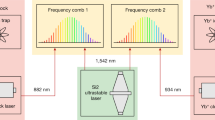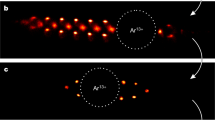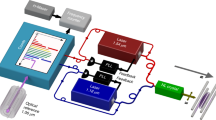Abstract
State-of-the-art optical clocks1 achieve precisions of 10−18 or better using ensembles of atoms in optical lattices2,3 or individual ions in radio-frequency traps4,5. Promising candidates for use in atomic clocks are highly charged ions6 (HCIs) and nuclear transitions7, which are largely insensitive to external perturbations and reach wavelengths beyond the optical range8 that are accessible to frequency combs9. However, insufficiently accurate atomic structure calculations hinder the identification of suitable transitions in HCIs. Here we report the observation of a long-lived metastable electronic state in an HCI by measuring the mass difference between the ground and excited states in rhenium, providing a non-destructive, direct determination of an electronic excitation energy. The result is in agreement with advanced calculations. We use the high-precision Penning trap mass spectrometer PENTATRAP to measure the cyclotron frequency ratio of the ground state to the metastable state of the ion with a precision of 10−11—an improvement by a factor of ten compared with previous measurements10,11. With a lifetime of about 130 days, the potential soft-X-ray frequency reference at 4.96 × 1016 hertz (corresponding to a transition energy of 202 electronvolts) has a linewidth of only 5 × 10−8 hertz and one of the highest electronic quality factors (1024) measured experimentally so far. The low uncertainty of our method will enable searches for further soft-X-ray clock transitions8,12 in HCIs, which are required for precision studies of fundamental physics6.
This is a preview of subscription content, access via your institution
Access options
Access Nature and 54 other Nature Portfolio journals
Get Nature+, our best-value online-access subscription
$29.99 / 30 days
cancel any time
Subscribe to this journal
Receive 51 print issues and online access
$199.00 per year
only $3.90 per issue
Buy this article
- Purchase on Springer Link
- Instant access to full article PDF
Prices may be subject to local taxes which are calculated during checkout


Similar content being viewed by others
Data availability
The datasets analysed in this study are available from the corresponding author.
Code availability
The experimental data were analysed using OriginLab and a self-written analysis script, which is available from the corresponding author. The Quanty code and its documentation are available from http://www.quanty.org. MCDHF 1 is described in ref. 51 and MCDHF 2 in ref. 55.
References
Ludlow, A. D. et al. Optical atomic clocks. Rev. Mod. Phys. 87, 637–701 (2015).
Katori, H. Optical lattice clocks and quantum metrology. Nat. Photon. 5, 203–210 (2011).
Marti, G. E. et al. Imaging optical frequencies with 100 μHz precision and 1.1 μm resolution. Phys. Rev. Lett. 120, 103201 (2018).
Brewer, S. M. et al. An 27Al+ quantum-logic clock with systematic uncertainty below 10−18. Phys. Rev. Lett. 123, 033201 (2019).
Nicholson, T. et al. Systematic evaluation of an atomic clock at 2 × 10−18 total uncertainty. Nat. Commun. 6, 6896 (2015).
Kozlov, M. G., Safronova, M. S., Crespo López-Urrutia, J. R. & Schmidt, P. O. Highly charged ions: optical clocks and applications in fundamental physics. Rev. Mod. Phys. 90, 045005 (2018).
Seiferle, B. et al. Energy of the 229Th nuclear clock transition. Nature 573, 243–246 (2019).
Nauta, J. et al. Towards precision measurements on highly charged ions using a high harmonic generation frequency comb. Nucl. Instrum. Methods Phys. Res. B 408, 285–288 (2017).
Cingöz, A. et al. Direct frequency comb spectroscopy in the extreme ultraviolet. Nature 482, 68–71 (2012).
Shi, W., Redshaw, M. & Myers, E. G. Atomic masses of 32,33S, 84,86Kr, and 129,132Xe with uncertainties ≤1 ppb. Phys. Rev. A 72, 022510 (2005).
Eliseev, S. et al. Direct measurement of the mass difference of 163Ho and 163Dy solves the Q-value puzzle for the neutrino mass determination. Phys. Rev. Lett. 115, 062501 (2015).
Crespo López-Urrutia, J. R. Frequency metrology using highly charged ions. J. Phys. Conf. Ser. 723, 012052 (2016).
Ushijima, I. et al. Cryogenic optical lattice clocks. Nat. Photon. 9, 185–189 (2015).
Huntemann, N. et al. Single-ion atomic clock with 3 × 10−18 systematic uncertainty. Phys. Rev. Lett. 116, 063001 (2016).
Sanner, C. et al. Optical clock comparison for Lorentz symmetry testing. Nature 567, 204–208 (2019).
Mehlstäubler, T. E. et al. Atomic clocks for geodesy. Rep. Prog. Phys. 81, 064401 (2018).
Safronova, M. et al. Search for new physics with atoms and molecules. Rev. Mod. Phys. 90, 025008 (2018).
Derevianko, A. & Pospelov, M. Hunting for topological dark matter with atomic clocks. Nat. Phys. 10, 933–936 (2014).
McGrew, W. F. et al. Atomic clock performance enabling geodesy below the centimetre level. Nature 564, 87–90 (2018).
Ong, A., Berengut, J. C. & Flambaum, V. V. in Fundamental Physics in Particle Traps 293 (Springer, 2014).
Dzuba, V. A. & Flambaum, V. V. Highly charged ions for atomic clocks and search for variation of the fine structure constant. Hyperfine Interact. 236, 79–86 (2015).
Gillaspy, J. D. Highly charged ions. J. Phys. B 34, R39 (2001).
Klaft, I. et al. Precision laser spectroscopy of the ground state hyperfine splitting of hydrogenlike 209Bi82+. Phys. Rev. Lett. 73, 2425–2427 (1994).
Morgan, C. A. et al. Observation of visible and UV magnetic dipole transitions in highly charged xenon and barium. Phys. Rev. Lett. 74, 1716–1719 (1995).
Crespo López-Urrutia, J. R., Beiersdorfer, P., Savin, D. & Widmann, K. Direct observation of the spontaneous emission of the hyperfine transition F = 4 to F = 3 in ground state hydrogenlike 165Ho66+ in an electron beam ion trap. Phys. Rev. Lett. 77, 826–829 (1996).
Schiller, S. Hydrogenlike highly charged ions for tests of the time independence of fundamental constants. Phys. Rev. Lett. 98, 180801 (2007).
Crespo López-Urrutia, J. R. The visible spectrum of highly charged ions: a window to fundamental physics. Can. J. Phys. 86, 111–123 (2008).
Berengut, J. C., Dzuba, V. A., Flambaum, V. V. & Ong, A. Highly charged ions with E1, M1, and E2 transitions within laser range. Phys. Rev. A 86, 022517 (2012).
Schippers, S. et al. Storage-ring measurement of the hyperfine induced 47Ti18+(2s2p 3P 0 → 2s 2 1S 0) transition rate. Phys. Rev. Lett. 98, 033001 (2007).
Träbert, E. et al. Time-resolved soft-X-ray spectroscopy of a magnetic octupole transition in nickel-like xenon, cesium, and barium ions. Phys. Rev. A 73, 022508 (2006).
Träbert, E., Beiersdorfer, P. & Brown, G. V. Observation of hyperfine mixing in measurements of a magnetic octupole decay in isotopically pure nickel-like 129Xe and 132Xe ions. Phys. Rev. Lett. 98, 263001 (2007).
Ritz, W. On a new law of series spectra. Astrophys. J. 28, 237–243 (1908).
Gu, M. F. The flexible atomic code. Can. J. Phys. 86, 675–689 (2008).
Brown, L. S. & Gabrielse, G. Geonium theory: physics of a single electron or ion in a Penning trap. Rev. Mod. Phys. 58, 233–311 (1986).
Zschornak, G. et al. Dresden Electron Beam Ion Sources: Latest Developments. Technical Report (Technische Universität Dresden & DREEBIT GmbH, 2009); https://www.researchgate.net/publication/228896380_DRESDEN_ELECTRON_BEAM_ION_SOURCES_LATEST_DEVELOPMENTS.
Koivisto, H., Arje, J. & Nurmia, M. Metal ions from the volatile compounds method for the production of metal ion beams. Rev. Sci. Instrum. 69, 785–787 (1998).
Roux, C. et al. The trap design of PENTATRAP. Appl. Phys. B 107, 997–1005 (2012).
Repp, J. et al. PENTATRAP: a novel cryogenic multi-Penning-trap experiment for high-precision mass measurements on highly charged ions. Appl. Phys. B 107, 983–996 (2012).
Cornell, E. A. et al. Single-ion cyclotron resonance measurement of \(M({{\rm{CO}}}^{+})/M({{\rm{N}}}_{2}^{+})\). Phys. Rev. Lett. 63, 1674–1677 (1989).
Feng, X. et al. Tank circuit model applied to particles in a Penning trap. J. Appl. Phys. 79, 8–13 (1996).
Karthein, J. et al. QEC-value determination for 21Na →21Ne and 23Mg → 23Na mirror-nuclei decays using high-precision mass spectrometry with ISOLTRAP at the CERN ISOLDE facility. Phys. Rev. C 100, 015502 (2019).
Birge, R. T. The calculation of errors by the method of least squares. Phys. Rev. 40, 207–227 (1932).
Smorra, C. et al. A parts-per-billion measurement of the antiproton magnetic moment. Nature 550, 371–374 (2017).
Grant, I. P. Relativistic calculation of atomic structures. Adv. Phys. 19, 747–811 (1970).
Desclaux, J. P., Mayers, D. F. & O’Brien, F. Relativistic atomic wave functions. J. Phys. B 4, 631–642 (1971).
Haverkort, M. W. Quanty for core level spectroscopy – excitons, resonances and band excitations in time and frequency domain. J. Phys. Conf. Ser. 712, 012001 (2016).
Indelicato, P., Parente, F. & Marrus, R. Effect of hyperfine structure on the 23P 1 and the 23P 0 lifetime in heliumlike ions. Phys. Rev. A 40, 3505–3514 (1989).
Gould, H., Marrus, R. & Mohr, P. Radiative decay of the 23S 1 and 23P 2 states of heliumlike vanadium (Z = 23) and iron (Z = 26). Phys. Rev. Lett. 33, 676–680 (1974).
Indelicato, P. et al. Hyperfine quenching and precision measurement of the 23P 0 − 23P 1 fine structure splitting in heliumlike gadolinium (Gd62+). Phys. Rev. Lett. 68, 1307–1310 (1992).
Birkett, B. et al. Hyperfine quenching and measurement of the 23P 0 − 23P 1 fine-structure splitting in heliumlike silver (Ag45+). Phys. Rev. A 47, R2454–R2457 (1993).
Indelicato, P. & Desclaux, J. MCDFGME: a multiconfiguration Dirac–Fock and general matrix elements program (2005).
Koepernik, K. & Eschrig, H. Full-potential nonorthogonal local-orbital minimum-basis band-structure scheme. Phys. Rev. B 59, 1743–1757 (1999).
Perdew, J. P. & Wang, Y. Accurate and simple analytic representation of the electron-gas correlation energy. Phys. Rev. B 45, 13244–13249 (1992).
Shabaev, V. M., Tupitsyn, I. I. & Yerokhin, V. A. QED-MOD: Fortran program for calculating the model Lamb-shift operator. Comput. Phys. Commun. 189, 175–181 (2015).
Froese Fischer, C., Gaigalas, G., Jönsson, P. & Bierón, J. GRASP2018 – a Fortran 95 version of the General Relativistic Atomic Structure Package. Comput. Phys. Commun. 237, 184–187 (2019).
Acknowledgements
This article comprises parts of the PhD thesis work of H.C., to be submitted to Heidelberg University, Germany. This work is supported by the German Research Foundation (DFG) Collaborative Research Centre SFB 1225 (ISOQUANT) and by the DFG Research UNIT FOR 2202. P.I. acknowledges partial support from NIST. Laboratoire Kastler Brossel (LKB) is supported by Unité Mixte de Recherche de Sorbonne Université, de ENS-PSL Research University, du Collége de France et du CNRS No. 8552. P.I., Y.N.N. and K.B. are members of the Allianz Program of the Helmholtz Association, contract number EMMI HA-216 ‘Extremes of Density and Temperature: Cosmic Matter in the Laboratory’. P.I. thanks J.-P. Desclaux for help in improving the MCDFGME code. This project received funding from the European Research Council (ERC) under the European Union’s Horizon 2020 research and innovation programme under grant agreement number 832848 - FunI. Furthermore, we acknowledge funding and support by the International Max Planck Research School for Precision Tests of Fundamental Symmetries (IMPRS-PTFS) and by the Max Planck, RIKEN, PTB Center for Time, Constants and Fundamental Symmetries.
Author information
Authors and Affiliations
Contributions
The experiment was performed by R.X.S., M.D., A.R. and S.E. The data were analysed by R.X.S. and S.E. Theoretical calculations were performed by H.B., M.B., H.C., Z.H., M.W.H. and P.I. The manuscript was written by R.X.S., M.B., Z.H., M.W.H., P.I., J.R.C.L.-U. and S.E. and edited by S.U. and K.B. All authors discussed and approved the data as well as the manuscript.
Corresponding authors
Ethics declarations
Competing interests
The authors declare no competing interests.
Additional information
Peer review information Nature thanks Jens Dilling, Marianna Safronova and the other, anonymous, reviewer(s) for their contribution to the peer review of this work.
Publisher’s note Springer Nature remains neutral with regard to jurisdictional claims in published maps and institutional affiliations.
Source data
Rights and permissions
About this article
Cite this article
Schüssler, R.X., Bekker, H., Braß, M. et al. Detection of metastable electronic states by Penning trap mass spectrometry. Nature 581, 42–46 (2020). https://doi.org/10.1038/s41586-020-2221-0
Received:
Accepted:
Published:
Issue Date:
DOI: https://doi.org/10.1038/s41586-020-2221-0
This article is cited by
-
Design and Implementation of an Einsteinian Energy Learning Module
International Journal of Science and Mathematics Education (2024)
-
Stringent test of QED with hydrogen-like tin
Nature (2023)
-
Mass spectrometry for future atomic clocks
Nature (2020)
Comments
By submitting a comment you agree to abide by our Terms and Community Guidelines. If you find something abusive or that does not comply with our terms or guidelines please flag it as inappropriate.



